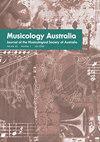Kungkarangkalpa Inma Alatjila Kuwari Palyani: Dancing the Seven Sisters Songline Today!
IF 0.4
0 MUSIC
引用次数: 1
Abstract
The focus of this article is the cross-cultural translation space of bicultural bilingual performance of Inma, traditional Pitjantjatjara song and dance. The article structure reflects the two languages and cultural concepts of storytelling, song and dance in which the Kungkarangkalpa Inma—Seven Sisters performance was presented at the Centenary of Canberra Indigenous Festival in 2013. This method of bilingual bicultural translation of words, song, dance and choreography was intrinsic to the many acts of translation involved in communicating the power, passion and meaning of a traditional Indigenous Inma performance to a western city audience. Inma song and dance conveys the connectivity of people to their Tjukurpa, the Law and Dreaming of their country. The performance space of translation is one in which people choose to share their culture by performing it in language, written or spoken, song, dance or mime, and translation occurs through intermediaries with some knowledge of both cultures who translate each to the other. The authors acknowledge that the acts of translation involved in translocating the desert Inma to the Canberra stage and the presentation of this in the secondary formats of a dialogue at an academic conference and now in a written article are all abstractions from the real performance of meaning in country of the Tjukurpa. Translation is but a reflection of meaning, a narrowing of the breadth of cultural referends of language, time and place. In this case, through several portals: a condensed city performance, a film of this performance, an oral bilingual conference dialogue and now a written account. This article references these portals and incorporates direct and indirect bilingual speech and reflection in an attempt to convey the importance of Inma song and dance in the cross-cultural communication of Indigenous knowledge of country.Kungkarangkalpa Inma Alatjila Kuwari Palyani:今天和Sonline七姐妹跳舞!
本文的重点是英玛、传统的皮詹特贾拉歌舞的双文化双语表演的跨文化翻译空间。文章结构反映了讲故事、唱歌和跳舞这两种语言和文化概念,2013年,在堪培拉土著节百周年庆典上,Kungkarangkalpa Inma——Seven Sisters的表演就体现了这一点。这种对单词、歌曲、舞蹈和编舞进行双语双文化翻译的方法,是向西方城市观众传达传统土著因玛表演的力量、激情和意义的许多翻译行为所固有的。Inma歌舞传达了人们与他们的Tjukurpa、法律和国家梦想的联系。翻译的表演空间是人们选择通过用语言、书面或口头、歌曲、舞蹈或哑剧表演来分享他们的文化的空间,而翻译是通过对这两种文化都有一定了解的中间人来进行的,他们相互翻译。作者承认,将沙漠Inma转移到堪培拉舞台所涉及的翻译行为,以及在学术会议上以对话的次要形式和现在的书面文章中对此的表述,都是对Tjukurpa国家意义真实表现的抽象。翻译只是意义的反映,是语言、时间和地点的文化参照广度的缩小。在这种情况下,通过几个门户网站:一场浓缩的城市演出,一部关于这场演出的电影,一场口头的双语会议对话,现在还有一篇书面报道。本文引用了这些门户网站,并结合了直接和间接的双语演讲和反思,试图传达因马歌舞在土著知识跨文化交流中的重要性。
本文章由计算机程序翻译,如有差异,请以英文原文为准。
求助全文
约1分钟内获得全文
求助全文

 求助内容:
求助内容: 应助结果提醒方式:
应助结果提醒方式:


